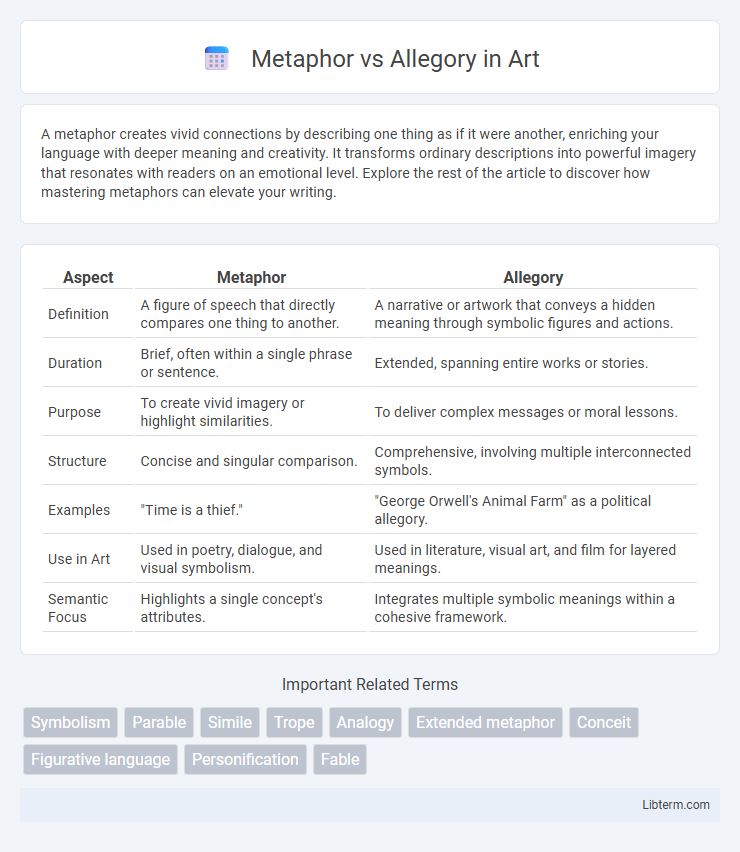A metaphor creates vivid connections by describing one thing as if it were another, enriching your language with deeper meaning and creativity. It transforms ordinary descriptions into powerful imagery that resonates with readers on an emotional level. Explore the rest of the article to discover how mastering metaphors can elevate your writing.
Table of Comparison
| Aspect | Metaphor | Allegory |
|---|---|---|
| Definition | A figure of speech that directly compares one thing to another. | A narrative or artwork that conveys a hidden meaning through symbolic figures and actions. |
| Duration | Brief, often within a single phrase or sentence. | Extended, spanning entire works or stories. |
| Purpose | To create vivid imagery or highlight similarities. | To deliver complex messages or moral lessons. |
| Structure | Concise and singular comparison. | Comprehensive, involving multiple interconnected symbols. |
| Examples | "Time is a thief." | "George Orwell's Animal Farm" as a political allegory. |
| Use in Art | Used in poetry, dialogue, and visual symbolism. | Used in literature, visual art, and film for layered meanings. |
| Semantic Focus | Highlights a single concept's attributes. | Integrates multiple symbolic meanings within a cohesive framework. |
Understanding Metaphor: Definition and Purpose
A metaphor is a figure of speech that directly compares two unrelated things by stating one thing is another, enhancing understanding through symbolism and vivid imagery. Its primary purpose is to create a deeper connection or evoke emotions by illustrating abstract concepts in a relatable manner. Metaphors often serve as concise tools for conveying complex ideas quickly and effectively in literature, speech, and everyday communication.
What is an Allegory? Key Characteristics
An allegory is a narrative technique in which characters, events, and settings symbolically represent abstract ideas, conveying deeper moral, political, or spiritual meanings beyond the literal story. Key characteristics of allegory include extended symbolism throughout the entire work, a clear one-to-one correspondence between elements in the story and their abstract counterparts, and an overarching message or lesson that reflects universal truths. Unlike a metaphor, which is a brief comparison between two unrelated things, allegory functions as a sustained and structured narrative that reveals multiple layers of meaning.
Core Differences Between Metaphor and Allegory
Metaphor is a rhetorical device where a single word or phrase directly represents another concept, creating an implied comparison to enhance meaning. Allegory, on the other hand, is an extended narrative or visual work where characters, events, or settings symbolically represent broader themes or moral qualities throughout the entire story or piece. The core difference lies in scale and complexity: metaphor operates at the level of individual expressions, while allegory functions as a sustained, overarching framework embodying multiple metaphorical meanings.
Functions of Metaphor in Language and Literature
Metaphors function as powerful cognitive tools that facilitate understanding by linking unfamiliar concepts to familiar experiences, enriching language with vivid imagery and emotional depth. They enable abstract ideas to be communicated succinctly, enhancing literary expression and reader engagement through imaginative interpretation. Unlike allegory, which operates as an extended narrative with symbolic meaning, metaphors typically function on a smaller, more immediate scale, influencing perception and meaning within individual phrases or sentences.
Allegory as Extended Metaphor: How They Interconnect
Allegory functions as an extended metaphor by using continuous symbolic representation throughout a narrative to convey complex ideas, moral lessons, or political criticism. Unlike a metaphor, which is a brief, direct comparison between two unrelated subjects, an allegory weaves multiple metaphors into a cohesive story where characters, events, and settings are imbued with deeper, often abstract meanings. This interconnectedness enables allegories to provide a layered understanding that requires interpretation beyond surface-level reading, enriching literary analysis and thematic exploration.
Famous Examples of Metaphor in Literature
Metaphors vividly convey complex ideas by directly equating one concept with another, as seen in Shakespeare's "All the world's a stage," illustrating life as a theatrical performance. In contrast, allegories use extended narratives like George Orwell's *Animal Farm*, symbolizing political ideologies through farm animals. Famous metaphors enrich literary works by providing layers of meaning that engage readers' imagination and insight.
Celebrated Allegories Through History
Celebrated allegories throughout history, such as George Orwell's "Animal Farm," utilize extended narratives to convey complex political critiques and moral lessons through symbolic characters and events. Unlike metaphors, which express ideas through brief comparisons, allegories provide a rich, immersive experience that unfolds across entire works, embedding layered meanings accessible through careful interpretation. These timeless allegorical stories continue to influence literature and culture by engaging readers in deep reflection on societal issues.
Interpreting Meaning: Context and Depth
Interpreting the meaning of a metaphor requires understanding its immediate context, as it conveys a direct comparison that enriches a single idea or image. Allegory, in contrast, offers layered symbolism that extends throughout an entire narrative, demanding deeper analysis of the broader context to uncover abstract, often moral or political, themes. Contextual knowledge is essential for both, but allegories typically require recognizing interconnected symbols to fully grasp the underlying message.
When to Use Metaphor vs Allegory in Writing
Use metaphor in writing to convey complex ideas succinctly by comparing one concept directly to another, enhancing clarity and emotional impact in brief passages or descriptions. Allegory suits extended narratives or works where deeper moral, political, or philosophical meanings unfold over time, allowing readers to explore layered symbolism throughout the story. Choosing metaphor benefits concise and vivid illustrations, while allegory is ideal for comprehensive thematic exploration.
Impact on Readers: Emotional and Intellectual Effects
Metaphors create immediate emotional connections by linking familiar concepts to new ideas, sparking imagination and personal reflection in readers. Allegories engage both emotions and intellect through sustained narratives that reveal deeper moral, political, or philosophical meanings, prompting critical thinking and ethical evaluation. The impact of metaphors is often more subtle and intuitive, while allegories foster comprehensive understanding and prolonged contemplation.
Metaphor Infographic

 libterm.com
libterm.com